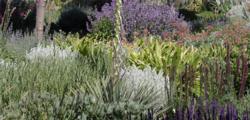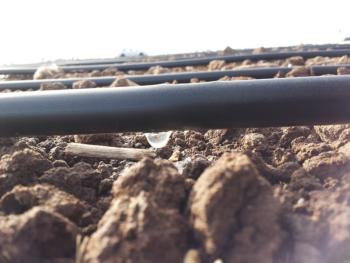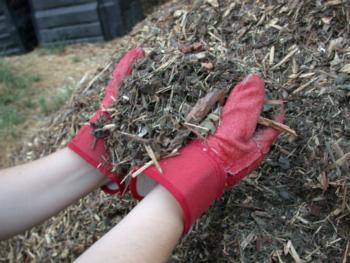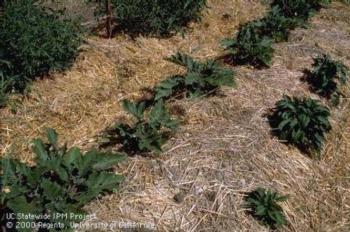Drought Tips for Home Gardeners
|
As California enters the driest year on record, efficient water management in the home garden is essential. Although plants different in the amount of water they need, lack of water can cause irreversible damage. In order to prevent damage, check plants regularly for symptoms of drought. These symptoms include:
In drought situations, many homeowners are forced to prioritize which plants to water. Below are some suggestions on how to maintain various plants during periods of drought. |
 Landscaping with drought tolerant plants can add color and interest to your yard while cutting down on water use. |
Ornamental Trees: Mature ornamental trees, especially those with relatively deep roots, should be able to survive with one or two deep irrigations several weeks apart in the spring and summer. However, drought-stressed trees can be more prone to damage from insects and diseases. Also, more than one season with minimal watering can result in severe drought stress and even death.
Fruit Trees: Fruit and nut trees can be kept alive with a few early-season water applications, but they may not set much fruit.
Vegetables: Vegetables are difficult to maintain during a drought. Know the critical watering periods for vegetables and you can target the timing and amount of water to add. As a rule of thumb, water is most critical during the first few weeks of development, immediately after transplanting, and during flowering and fruit production. Tomatoes, beans, and root crops such as carrots require regular watering and are not tolerant to long, dry periods. Viney vegetables such as squash and zucchini often fare better and can be kept alive with a few waterings once or twice a week through the season.
Planting Strategies
- Plant shorter season crops and fewer crops
- Plant in blocks, rather than rows. This creates shade for roots and reduces evaporation.
- Control weeds, they are competing with the vegetables for the water supply.
- Use containers or plant vertically to reduce the soil area that needs irrigation
- Zones! Group plants with similar water needs (i.e. families) together on the same soaker hose. Cucumber and zucchinis and squash, for example, require similar water applications.
- Provide windbreaks to reduce evaporation of moisture from soil and plants.
- Amend your soil with organic matter to increase the water holding capacity.
- MULCH!
Shrubs: Most established shrubs can survive long periods of dry soil. Thorough spring watering and one or two thorough waterings in the summer keeps most well-established shrubs alive for at least one season.
Ground Covers: Ground covers often survive on about half the amount of water they would receive under optimal conditions, although some dieback may occur. To avoid serious drought stress, they should be watered at least every 3 to 6 weeks during spring and summer.
Lawns: Unfortunately, the cool season grasses (e.g. tall fescue and ryegrass) that are generally planted in Plumas & Sierra Counties are less drought-efficient than warm-season lawns (i.e. bermudagrass and buffalograss). Cool season grasses may die within a month or two of receiving no water. Signs of drought include wilted leaves and a blush-gray appearance followed by yellow leaves that will eventually turn brown. Cutting the length of irrigation down to ½ of that recommended in the UC Lawn Watering Guide http://anrcatalog.ucdavis.edu/pdf/8044.pdf and watering only once or twice a week may help get your lawn through the drought. Also, higher mowing heights maximize photosynthesis and reduce turf stress.
Efficient Irrigation
|
Practicing efficient irrigation is essential during periods of drought. Below are some best practices that should be followed to help increase water efficiency. Drip Irrigation: Drip irrigation systems are ideal for home gardens and can reduce water usage by 50%! Drip irrigation systems are relatively easy and inexpensive to set up and can be attached to timers for ease and to ensure plants are watered at the optimal time of day. Visit the links below for more information on setting up and using drip irrigation systems. |
 Drip irrigation applies just the right amount of water to only the plants that need it without overspray or runoff improved for irrigation efficiency. |
Drip Irrigation - Intermediate
Drip Irrigation System Design & Installation
Calculating Drip Irrigation Schedules
Place soaker hoses or drip irrigation under mulches.
Check soil moisture regularly to avoid over-application: Squeeze soil in your hand; if it sticks together, it is moist and irrigation should be delayed. If the soil has dried out to a depth of 2-4 inches, plan to water. This is especially important if using mulch, where water can be held in the soil for longer periods of time.
Know the critical watering periods for vegetables
Water during early morning, when wind is low and temperatures are cool.
Rain Barrels: Rain barrels can collect and store rainwater from rooftops for garden use. It’s important to note that the water is not potable, if you use it on vegetables, avoid overhead irrigation – drip irrigation is better. Do not use it to wash fruits or vegetables prior to consumption.
MULCH: Mulching is an easy and effective way to conserve water in the garden by minimizing evaporation from the soil surface. Good mulching can reduce irrigation need by 50%!!
- Use an organic mulch to a depth of 1-3 inches, depending upon the particle size of the mulching material - the larger the particle, the thicker the depth of mulch that should be applied.
- Mulch only after the soil has warmed sufficiently.
- Do not use wood or bark chips in a garden setting that requires annual soil preparation. The chips will interfere with future seedbed preparation.
- Grass clippings make excellent mulch for the vegetable garden. Apply fresh clippings in thin layers (up to ¼ inch thick) and allow each layer to dry before adding more. The clippings quickly drydown and additional layers can be added weekly. Do not use clippings from lawns that have been treated with herbicides or other pesticides in the past month. A couple of sheets of newspaper may be used under the clippings to help control weeds.
- Black or colored plastic mulch conserves moisture and also increases soil temperatures. They can be used on tomatoes, peppers, eggplants and the vine crop family (cucumbers, summer and winter squash, melons).
- Wood chips make great mulch for trees and shrubs.
 |
 |
Other Resources
FAQs about Water Conservation and Drought in Landscapes
Colorado State University Extension Drought Resources
Adapted from materials provided by Colorado State University Extension and Janet Hartin and Ben Faber of University of California Cooperative Extension

